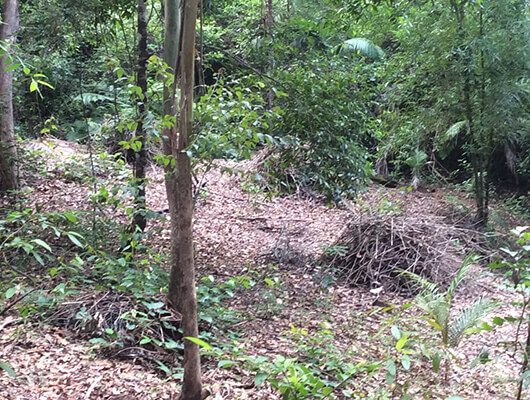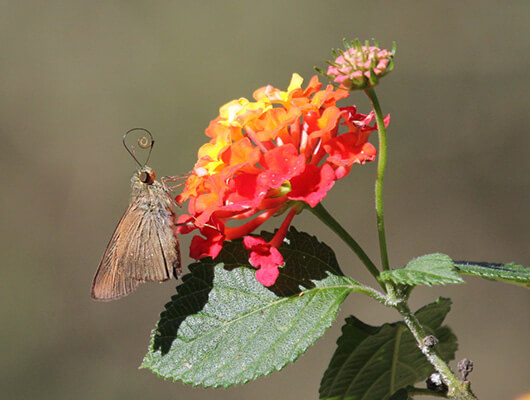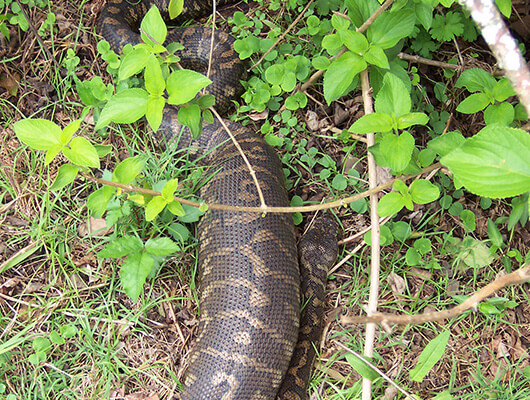Lantana camara is possibly the most widespread weed in southeast Queensland (SEQ); very few rural properties can claim a lantana-free status. It covers an estimated four million hectares of eastern Australia, often to the exclusion of wildlife, people and livestock.
Despite being considered in the top ten of the world’s worst weeds and a ‘Weed of National Significance’, landholders don’t actually have a legal requirement to control lantana. However many landholders do feel compelled to reduce its extent.
But not everyone feels this way. I often hear the comments, “but it’s great habitat for birds” or “it provides important cover for wildlife”. So, which is it? Great habitat? Or serious weed? Well, like many polarised debates the answer probably lies somewhere in the middle and is often site specific.
Many Land for Wildlife properties in SEQ consist of regrowth forests that have a history of logging and/or grazing, providing ideal disturbed niches for lantana to grow. Lantana is not a fussy plant, it grows in most SEQ vegetation communities. As far as plants go, it’s somewhat of a ‘shape shifter’. It adapts its growth form in response to environmental conditions. In high rainfall areas it can form impenetrable thickets that blanket entire hillsides of neglected pasture. In regrowth forests where it struggles for light it will climb up and over trees creating lantana ‘towers’, while in drier, ‘hungrier’ country it can form tough, raspy shrubs. It can also send long runners out along the ground, which then shoot skywards when they find a sunny gap. This adaptability, coupled with the fact that there are hundreds of recognised varieties of this nursery manufactured ‘species’, makes generalising about Lantana camara and its control somewhat problematic.
So why is lantana considered a problem? For starters it’s highly invasive. First introduced into a Sydney garden in the 1840s it quickly spread. By 1889 the first dense stands were mapped close to the mouth of the Brisbane River. Eight years later it was described as Brisbane’s “most troublesome weed” that formed “impenetrable thickets on the banks of stream, deserted farms and the edges of scrubs”.
Lantana seeds are dispersed by birds and mammals and germinate readily, especially in disturbed areas. While seed viability decreases with time (about a quarter will germinate after 36 months) some have been found to remain viable for up to 11 years. Lantana establishes rapidly in disturbed sites at the expense of other plants, due to its fast growth rates and allelopathic effects (toxicity to other plants).
Regenerating native seedlings are shaded out, as are groundcovers and grasses, existing shrubs and small trees can be smothered and are eventually pulled down by the sheer weight. So in essence, it can stall the successional process of regrowing forests and dominate the understorey of disturbed forests, especially if the canopy has been opened up through activities such as logging. Combined, these impacts can lead to a reduction in biodiversity.
Lantana provides cover for some undesirable feral animals such as cats, pigs, rabbits, foxes and wild dogs, which have all been shown to take cover in lantana thickets. Contributing to another threatening process for wildlife, lantana can promote changes in fire regimes, in some instances it can increase wildfire intensity, while in others situations it can limit the spread of fire.
On grazing properties lantana is not just a problem because it competes with pasture, it is also toxic to livestock. The economic costs of lantana to the grazing, forestry and conservation sectors are very high. In 2005/06 it was estimated that the Australian grazing industry alone was losing $104 million per year in lost productivity as a result of lantana. So we have heard from the nay side of the debate, what about the ayes?
On the ‘great habitat’ side of the debate, lantana provides food for a range of wildlife. For example I have often observed Richmond Birdwing butterflies and numerous species of honeyeaters feeding on the nectar of lantana flowers. Birds such as Silvereyes, Pied Currawongs, Satin Bowerbirds and Lewin’s Honeyeaters eat the small fruits. The vulnerable Blackbreasted Button-quail utilises lantana for day-time foraging and nocturnal roosting and lantana thickets are considered Lantana weed profile NOXIOUS WEED OR GREAT HABITAT? It is impressive what some Land for Wildlife members are willing to tackle! This steep gully with rocky scree slopes was wall-to-wall lantana. Slowly the landholders are controlling it in stages targeting any existing trees as a priority. The dead lantana tower in the foreground offers an indication to how high this weed can climb into the canopy. Photo by Nick Clancy, taken on a Land for Wildlife / Nature Refuge property near Wootha, headwaters of the Stanley River catchment. 1 0 LAND FOR WILDLIFE SOUTH EAST QUEENSLAND JULY 2018 a crucial component of their habitat requirements in some locations.
Of the numerous native species that utilise lantana thickets as habitat, it is the dense growth structure that makes it attractive. Whipbirds, scrubwrens, Pheasant Coucals and fairywrens all utilise the dense structure provided by lantana. Bandicoots, wallabies and pythons will use lantana as a refuge during daylight hours. Its habit of occupying forest edges is also useful for species such as Red-necked Pademelons as it provides dense cover from predators immediately adjacent to more open foraging areas. Prior to 1840 all of these native animals thrived in an environment without lantana, and in the absence of their pre-European habitat they have adapted to utilise lantana in various ways. So there is no doubt that lantana provides habitat opportunities for a range of wildlife. But does this mean that we should simply leave lantana wherever it grows and assume that everything is hunky-dory in downtown lantana land?
Well, in some instances the answer is probably yes. For example where there is an absence of alternative cover for lantana dwelling native wildlife. Also, where lantana forms a fringing thicket along forest margins, then it can function well as an ‘edge’ plant. As an edge plant it can help to exclude livestock from natural areas or waterways. The buffer provided can be beneficial, preventing spread of other weeds into the forest. However in this context lantana is not providing anything that structurally-similar natives such as Native Raspberry (Rubus spp.) can’t also provide.
In many cases I would suggest that we can do better than simply leaving lantana, especially in the mosaic of remnant, regrowth and open country that occurs on many Land for Wildlife properties.
Where lantana forms a mono-cultural land blanket it offers a very simplified habitat. By this I not only mean structurally, but it only provides one variety of flower, fruit and foliage. When the dominant lantana is not flowering or fruiting, alternative food sources are limited. If, as ‘Land for Wildlifers’, it is our objective to expand and improve the habitat resources available to native wildlife on our properties, then we should aim to replace lantana with a suite of endemic plants. This doesn’t always mean that you need to plant trees either, often when lantana is removed we release the brakes on natural regeneration, stimulating a flush of germinating native plants from all strata including herbs, ferns, grasses, shrubs, trees and vines.
With assistance, this regenerating pulse of plants can provide a greater variety of both structure and feeding opportunities, offering a range of foliage, flowers, seeds and fruits throughout the year. Over time the subsequent increase in plant and invertebrate diversity will likely result in an increase in the diversity of wildlife.
Of course there is a lag effect. For a time there will be limited cover available in the cleared area. For this reason it is often recommended to stage your lantana control so you are not removing large areas all at once. This is not only better for the wildlife but it also means you are more likely to keep up with the required maintenance. Regardless of the method employed the key to successful control is follow-up weeding. Manual control can be done in autumn outside the usual breeding season for most small birds and when the weather is mild. Chemical control is best done in the summer growing season. While the clumps will lose their foliage after spraying they will maintain a dense structure of canes through to autumn when the brittle frame can be knocked down manually.
Try to assess your lantana patches objectively, take some time to determine the beneficial habitat roles that a patch may be providing but also assess what’s being smothered and/or suppressed. Consider the potential diversity of plants that may be locked up in the soil seed bank. Look around and see what alternative dense thickets are available and also check what other weeds may be waiting to move in once the lantana is removed. Other invasive species such as Broad-leaved Paspalum are best controlled prior to tackling lantana, otherwise you will end up with one weed replacing another.
For better or worse, lantana is here to stay as an entrenched component of SEQ ecosystems. Many properties will have lantana patches that may never reach the top of their owners’ priority list, they will remain for the next generation of land managers to consider. Wherever lantana grows a range of native animals will continue to take advantage of its resources and some observant landholders will choose to keep some patches of lantana for dependant species such as whipbirds and the Black-breasted Button-quail. Other landholders will choose to remove lantana patches and restore native forest cover to the benefit of other animal species and some will choose to have a bet each way.
Article by Nick Clancy
Land for Wildlife Officer
Sunshine Coast Council
References and further reading
Low T (1999) Feral Future: The untold story of Australia’s exotic invaders. Penguin.
Low T (2017) The New Nature: Winners and losers in wild Australia. Penguin.
Stock D (2009) Lantana: Best practice manual and decision support tool. Dept of Employment, Economic Development & Innovation Qld.




Interesting article ! My regen aim is remove all lantana, with natural regrowth or replace suitably.
I’m really enjoying how our gullies look lantana free with new regen and structures appearing. In some places we have ferns and sandpaper figs thriving where lantana was.
It’s also amazing to be able to access areas that were previously huge dense impassable thickets
One big issue is with a gully fed by street storm water how to keep up with weed seeds.
Re: how to keep up with weed seeds from outside of site. Wondering how you have gone with this over the past three years? It is a big issue, and probably forever, but the amount of effort required to keep re-infestation from a big problem decreases over time. And very much easier than letting it go to weed dominant again.
Example; in one of our local Landcare reveg sites we had a major problem with centro. It was so severe that one earlier section, 0.1Ha, had a 60% mortality rate from being entire overcome and strangled. Two working-bees of manual cutting and treating stems of climbers followed by foliar spray.
Some infill planting with mulching and hand watering (twice as hard as doing it right from the getgo) and regular foliar spray of herbicide brought it back to the ‘successful’ column. It takes about four or five years to get on top of the seed bank in the soil, and with canopy finally starting to take effect, the amount of herbicide and effort required is now is minimal, despite between wedged between a creek that floods seasonally and council mowed grass.
Timing is critical. Responding to growing conditions so that we are tackling something 100mm in height rather than waiting until it is over a metre, and potentially seeding, is clearly the wtg, with much less total time required.
In the first year of tackling this small infestation I estimate (conservatively) 150 hrs of labour was applied, now it would be less than 1.5 hours annually. So if someone states that it is one hundred times easier to prevent than cure a weed problem, that isn’t hyperbole, its about right.
Further to my earlier comment, https://www.lfwseq.org.au/seedlings-vs-weedlings/ is highly relevant. In the way we take for granted what we already know, I tend to forget how hard it is to spot the good Vs evil.
Interesting article, the corner block is full of latana and i know, the small birds used to go there, but with noisy miner issue here dont really see them anymore. I have removed it from our property, it was trying to climb up into the creek line rainforest i created some years ago. I wonder if native alternatives like native raspberry that can grow into thorny thickets would the small birds
“The key to successful control is follow-up weeding.”
Large bold caps with flashing highlight to this simple statement. The instinct to ‘do it all and do it now’ gets some people overwhelmed and disheartened. Taking a smaller bite at the problem and consolidating gains can be much more successful (and satisfying).
Related to this is the “one weed replacing another” danger. Due to it’s allelopathic effect, lantana suppresses other weeds. Great care needs to exercised to prevent worse weeds prospering after lantana is controlled. If you aren’t sure you can commit to ongoing control, it may be better to leave it as is
The good news is: a) lantana seems to leave soil in good condition after removal (nitrogen fixing?) and b) there is a good chance that juvenile native species are already there under the thicket, and will burst into vitality when relieved from chemical suppression.
To benefit from part-b, with whatever means of control you adopt, take care not to damage the natural recruits. Landholders and NatParks have had success with splatter gun in my area (NQ) but on modest scales it is hard to improve on the targeted assault.
Dress like a leather-fetishist bee-keeper and find the stems. Hand tools will be adequate for most jobs, with longhandled loppers my preference, and immediately treat root stem with glyhosate360 (1:1 with water) from dabber. Ensure the cut plant-stem doesn’t contact the soil or it might take root again. A week later the bits you missed will be obvious. A month later there will be some small bits you missed that have seized their moment, but also any natural recruits that were lurking like resistance fighters undercover during the invasion.
Over the next couple of years periodic inspection and very little effort are required. But don’t turn your back entirely and fall for the temptation to prematurely claim ‘mission accomplished’, thinking you have conquered the invader. Be alert, not alarmed, and you will have long term resolution.
Thank you Dave for sharing your expertise here.
What do you consider to be the best method for disposing of the lantana waste after manual clearing? Is it acceptable/wise to burn the lantana waste or should it be dumped at a local authority green waste facility? Your guidance would be appreciated.
Hi Steve. Lantana can usually be piled up, or simply left on the ground (with the roots not touching the ground). The stalks should just mulch down and decompose. No need to remove it from the site.